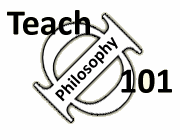Teach Philosophy 101
Free resources for
philosophy teachers!
"One of the most comprehensive, well-researched, and accessible guides for teachers that I have ever seen." James Lang, Chronicle of Higher Education (read full review of TΦ101)
Copyright Issues
TΦ101 strongly recommends that instructors be scrupulous about intellectual property. If we expect our students to respect our expectations regarding academic integrity, we should model conscientious behavior ourselves. There are legal and appropriate ways to obtain material for your course. Here are some informal guidelines, but please consult your institution's general counsel for legal opinion.
Legal Sources for Course Material:
-
Public Domain. Anything published before 1925 can safely assumed to be in the public domain, and you may copy or reprint it in any way you wish. Many of the classic texts of philosophy are available in older translations and may be obtained, for example, from project Gutenberg. One must also be careful of modern editions since the footnotes, introductions, and other associated materials might be protected.
-
Fair Use. The U.S. copyright code provides some legitimate opportunities for instructors to reproduce works and distribute them to their students. The general idea is that the copying must be done for an educational purpose, must be a portion of the work (some people suggest that the copied portion should be less than 5% of the total work), and must not impact the market value of the copyrighted work. So, for example, if you want your students to read a recent translation of Plato's allegory of the cave, you may certainly copy it from a contemporary translation, since the passage is less than 5% of the Republic, and the fact that you are copying this passage won't have any impact on the sale of the whatever translation of Republic you have used.
-
Using Video Material. A lot of professors use short clips from movies to illustrate points or stimulate discussion in their classes, and there is a lot of software out there that makes it possible to put segments of a DVD on a hard drive. Recent regulation changes, which TΦ101 does not pretend to understand, now give professors much more leeway in extracting short media clips for use in classes.
-
Obtaining copyright permission. Ultimately it is not that difficult to obtain copyright permission for more or less anything that interests you; there will usually be a fee, but it will typically be far less than the cost for your students of purchasing the entire book. The simplest way is to work with the Copyright Clearance Center, a non-profit company that can obtain copyrights on many published works.
-
Your institution's library. If your institution has it in their library, then the material contained in the work can be put on course reserve, or, if your institution owns the ebook, you can download sections and make use of it in your courses.
Details on Fair Use:
Fair Use is defined as follows in: Section 107 of Title 17, United States Code regarding Copyright Law:
107. Limitations on exclusive rights: Fair use.
Notwithstanding the provisions of section 106 and 106a, the fair use of a copyrighted work, including such use by reproduction in copies or phono records or by any other means specified by that section for purposes such as criticism, comment, news reporting, teaching (including multiple copies for classroom use), scholarship, or research, is not an infringement of copyright. In determining whether the use made of a work in any particular case is a fair use the factors to be considered shall include:
1. the purpose and character of the use, including whether such use is of a commercial nature or is for nonprofit educational purposes;
2. the nature of the copyrighted work;
3. the amount and substantiality of the portion used in relation to the copyrighted work as a whole; and
4. the effect of the use upon the potential market for or value of the copyrighted work. The fact that a work is unpublished shall not itself bar a finding of fair use if such finding is made upon consideration of all of the above factors.
Sources:
Sprigman, Chris, "THE MOUSE THAT ATE THE PUBLIC DOMAIN: Disney, The Copyright Term Extension Act, And eldred V. Ashcroft ." FindLaw, March 5, 2002. 18 January 2008
Author: John Immerwahr
Update: 10/13/25--David Sackris
